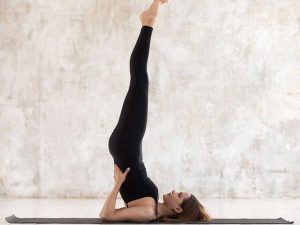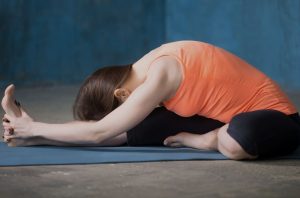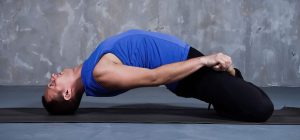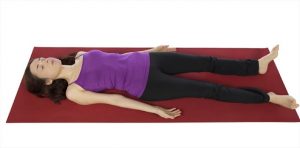HYPERTHYROIDISM – YOGA ASANAS
- December 20, 2022
- Posted by Dr. Vaidya Karanvir Singh
- 0 Comment(s)
Table of Contents
WHAT IS HYPERTHYROIDISM?
Hyperthyroidism is a condition in which the thyroid gland works overactively. It is also known as overactive thyroid. There are two types of thyroid hormones – thyroxine (T4) or triidothyronine (T3). These hormones are responsible for maintaining body’s metabolism. When thyroid gland produces increased amount of these hormones, then it speeds up the metabolism leading to symptoms like rapid weight loss, increased appetite, heart palpitations, anxiety, etc.
There are various treatment options available for it. Medications like antithyroid medicines, radioiodine are used which helps in decreasing the amount of thyroid hormones. In some cases, surgery is performed for a part or complete removal of thyroid gland. However, with dietary and lifestyle modifications, it can be managed upto a large extent.
WHAT ARE THE CAUSES OF HYPERTHYROIDISM?
Thyroid gland is a butterfly-shaped gland which is present at the base of the neck. It is responsible for all the metabolic processes of the body. The hormones produced by it are T3 and T4. These hormones help in breakdown of fats, carbohydrates and proteins. They help in regulation of body temperature. They have an effect on heart rate also.
Hyperthyroidism is a medical condition in which there is too much production of thyroid hormones. There are various underlying conditions which can lead to increased production of thyroid hormones:
- Thyroid nodules
- Inflammation of the thyroid gland known as thyroiditis
- Graves’ disease
- Increased intake of iodine
- Pernicious anemia
- Recent pregnancy
- Adrenal insufficiency
WHAT ARE THE SYMPTOMS OF HYPERTHYROIDISM?
The symptoms which are associated with hyperthyroidism are:
- Rapid weight loss
- Tachycardia-increased heart rate
- Irregular heartbeat
- Increase in appetite
- Heart palpitations
- Anxiety
- Restlessness
- Tremors in hands and fingers
- Irritability
- Sweating
- Irregular menstrual cycle
- Frequency of bowel movements
- Fatigue
- Body weakness
- Enlargement of thyroid gland
- Difficulty in sleeping
- Thinning of hair
- Blurry vision
- Intolerance to heat
- Hair loss
- Bulging of eyes
WHAT ARE THE COMPLICATIONS WHICH ARISE WITH HYPERTHYROIDISM?
There are various complications which arise with hyperthyroidism. Following are the complications:
- Osteoporosis
- Atrial fibrillation
- Thyroid storm
- Miscarriage
- Premature birth
- Stroke
- Congestive heart failure
- Thyroid cancer
YOGA FOR HYPERTHYROIDISM
There is increasing prevalence of thyroid problems now-a-days due to unhealthy lifestyle and eating habits. They come after diabetes and hypertension. Women are more prone to them in comparison to men. There are numerous treatment options available but yoga and meditation can be very helpful in treating thyroid disorders. Regular practicing of the yoga helps in reducing stress and improves the quality of life of an individual.
Following are the yoga asanas which are best suited for curing thyroid disorders:
1. SARVANGASANA
Sarvangasana is also known as shoulder stand. It is a yoga pose in which the whole body is balanced on the shoulders. Sarv means all, anga means a part of body and asana means body posture. It has an influence on the functioning of all the body parts. This asana is known as Queen of the asanas. It is very beneficial for maintaining physical and mental health.
How to do it:
- Lie on the back with hands on the side
- Then, with one movement, lift the legs, buttocks and back so that their weight comes on the shoulders. Support the back with both the hands.
- Keep the legs and spine straight with the help of elbows and hands to the back. The weight should be supported on shoulders and upper arms not on head and neck.
- Breathe deeply while maintaining the posture for 30-60 seconds.
- Then, lower the knees to forehead and bring your hands down to the floor. Without lifting the head, bring the spine down. Lower the legs on the floor and relax for a minimum of 60 seconds.
Contraindications:
- Pregnancy
- Menstruation
- Hypertension
- Glaucoma
- Slip disc
- Neck pain
- Spondylosis
2. JANUSHIRSHASANA
Janu means knee and shirsha means head. Janushirshasana means head touching knee posture. The asana shouldbe performed empty stomach.
How to do it:
- Sit with legs stretched out in front, keep the spine erect.
- Bend the left knee and place the left foot against the right thigh, the left knee is on the floor.
- Raise both the arms up while breathing in and bend forwards from the hip joint while breathing out. Keep the spine straight during bending.
- Hold on to the big toes for as much time as a person feels comfortable. Keep breathing.
- Then, come up while breathing in and out. Bring the arms down to the sides.
- Then repeat the same procedure on the other side also.
Contraindications:
- Back pain
- Hernia
- Any recent abdominal surgery
- Neck injury
3. MATSYASANA
Matsyasana is the fish pose asana. If this asana is carried out in water, the body will float easily like a fish.
How to do it:
- Lie on back with feet together and hands relaxed.
- Place the hands under the hips and bring the elbows close to each other.
- Lift the head and chest up while breathing in.
- When the chest is elevated, lower the head backwards and touch floor with the top of the head.
- Hold the pose as long as a person feels comfortable.
Contraindications:
- High or low blood pressure
- Migraine
- Insomnia
4. SHAVASANA
Shava means corpse and asana means body posture. Shavasana is also known as corpse pose. This asana is a rest and relaxation posture. It is usually performed at the end of a yoga session. It helps in deep healing of the body.
How to do it:
- Lie flat on the back without any cushions or props. Close your eyes.
- Keep the legs apart comfortably and let the feet and knees relax.
- The arms should be kept aside with a little distance from the body. Keep the palms open and facing upwards.
- Breathe slowly and gently and slowly relax your entire body. Surrender the whole body and let go everything. But do not fall asleep.
- After 10-20 minutes, slowly roll onto the right side and remain in that position for a minute. Then with the help of the right hand, sit up into a seated posture known as sukhasana.

Dr. Vaidya Karanvir Singh is the younger Vaidya in Chandigarh Ayurved & Panchakarma Centre. He is the fourth generation in his family who is practicing as a general consultant in Ayurved & Panchakarma treatment at Chandigarh. In his practice, he had treated more than 1 Lakh Plus patients worldwide.





